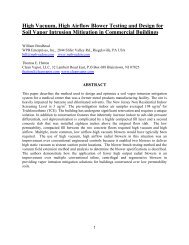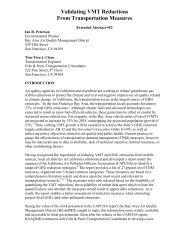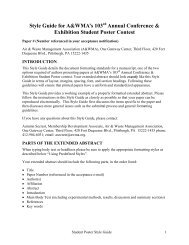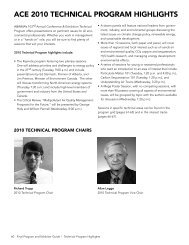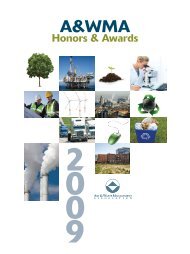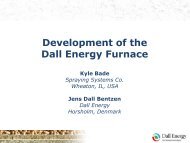Abstract Book
Abstract Book
Abstract Book
You also want an ePaper? Increase the reach of your titles
YUMPU automatically turns print PDFs into web optimized ePapers that Google loves.
Activated Carbon Fiber (ACF) is capable of removing NOX from the atmosphere.<br />
Therefore, it is very effective for reduction of the ambient NO2 concentration in urban<br />
areas to set up a permeable fence filled with ACF near arterial roads; hereafter, this fence<br />
is called the ACF fence. In this work, to develop the NOX purification method using the<br />
ACF fence, we conducted a wind tunnel experiment simulating a roadside gas diffusion<br />
process around the ACF fence and investigated the NOX removal performance of the<br />
ACF fence under homogeneous wind condition. Concentrations of NO2 and NO were<br />
measured just before and after the ACF fence. To quantitatively evaluate the NOX<br />
removal performance of the ACF fence, the NOX removal rate were estimated on the<br />
basis of concentration statistics. Experiments were conducted for two types of ACF<br />
fence, that is, a panel-shaped fence and a slit-shaped fence. In case where the panelshaped<br />
fence was installed on the leeward side of the road, the local removal rate of NO2<br />
was up to 100 % and the local removal rate of NO was up to 35 %. In case where the slitshaped<br />
fence was installed on the leeward side of the road, the overall removal rates were<br />
higher than observation values on the verification test site. The overall removal rates of<br />
NO increased for lower wind velocity case. This suggests that increasing contact<br />
efficiency between polluted air and ACF surface layer is effective for NO removal.<br />
Particle Manner In SEP (176)<br />
M. Telenta; Faculty of Mechanical Engineering, Skopje, Macedonia, The Former<br />
Yugoslav Republic of<br />
The objective of this paper is to calculate the effect of Coulomb forces on particle<br />
coagulation rate, collision frequencies for particles in laminar shear flow, collision<br />
frequency for particles in Brownian motion, and collection of particles on a cylindrical<br />
obstacle representing the screen wire. It will give an overview of the mechanisms that are<br />
prevailing in particle collection, and therefore, which mechanism will be more effective<br />
in particle removal for certain particle size.<br />
Charging has an effect on the bigger particles where particles acquire larger amount of<br />
charges. Expected particle interaction is higher in the vicinity of the obstacle rather than<br />
away from it. Collision frequency is large for combination of very small and very large<br />
particles. Collision frequency for Brownian motion increases with the particle size. Also,<br />
one can observe that collision frequency is higher in case of smaller particle interacting<br />
with the other particles. Further more, collision frequency decreases when an observed<br />
particle is bigger than the one it interacts with.<br />
One can see that inertial impaction occurs for particles larger than 5 μm since Stokes<br />
number for these particles is larger than Stokes critical number. Also, one can conclude<br />
that inertial interception increases with the increase of the particle size, which is<br />
expected.<br />
Keywords: aerosol, particle collection, Coulomb force, coagulation, SEP<br />
Experimental Measurements And Mass Transfer/reaction Modeling For An<br />
Industrial NOx Absorption Process (90)<br />
32




